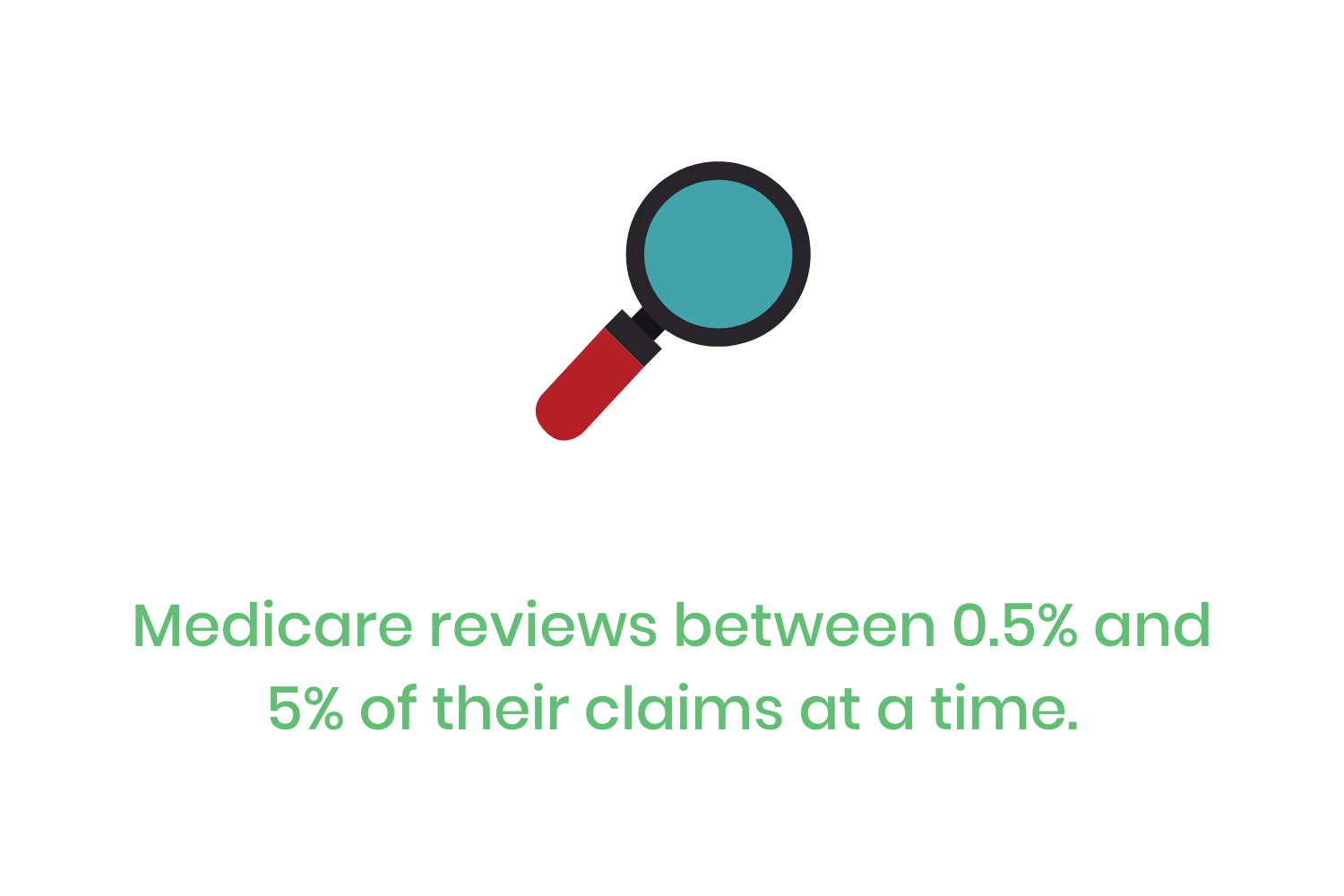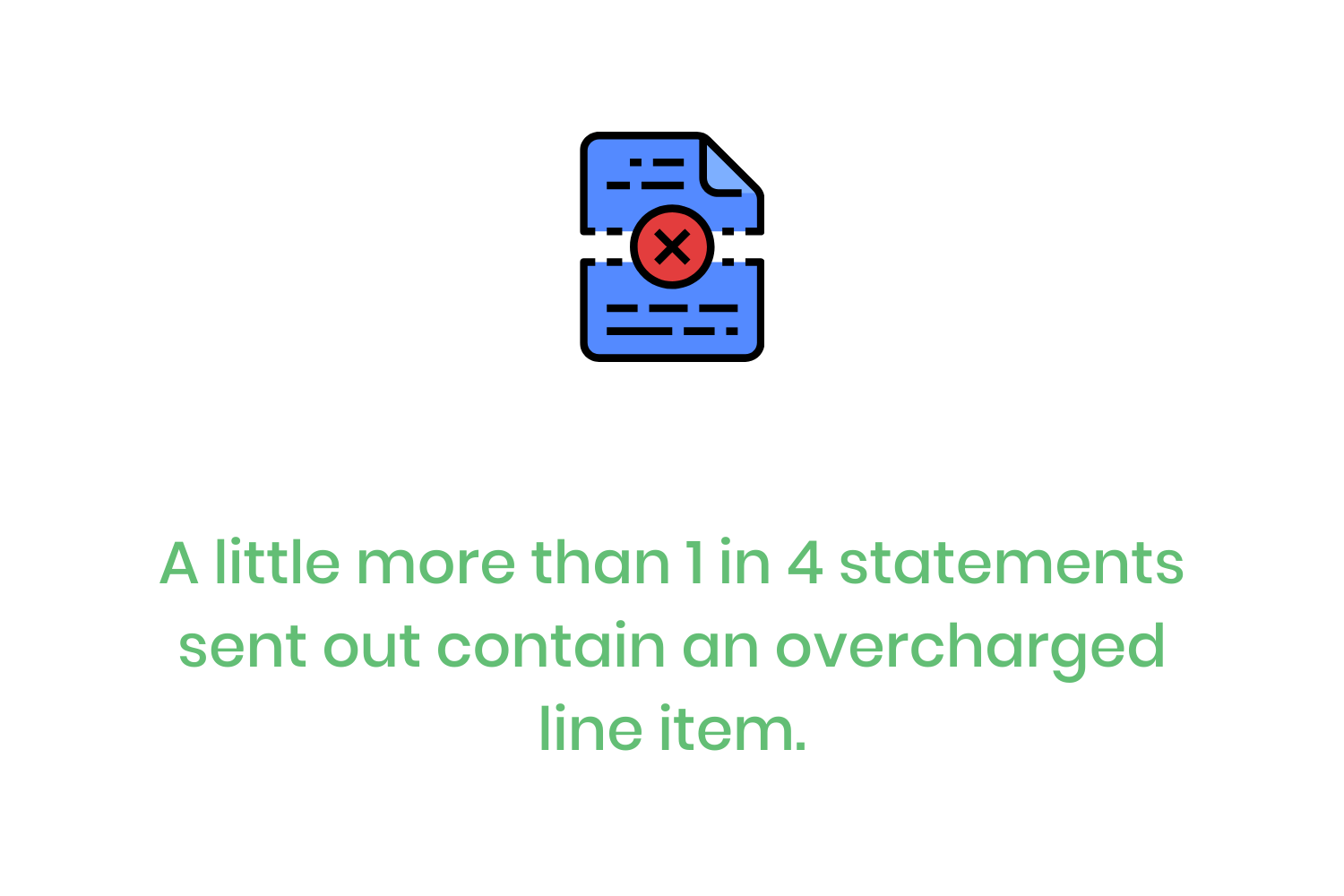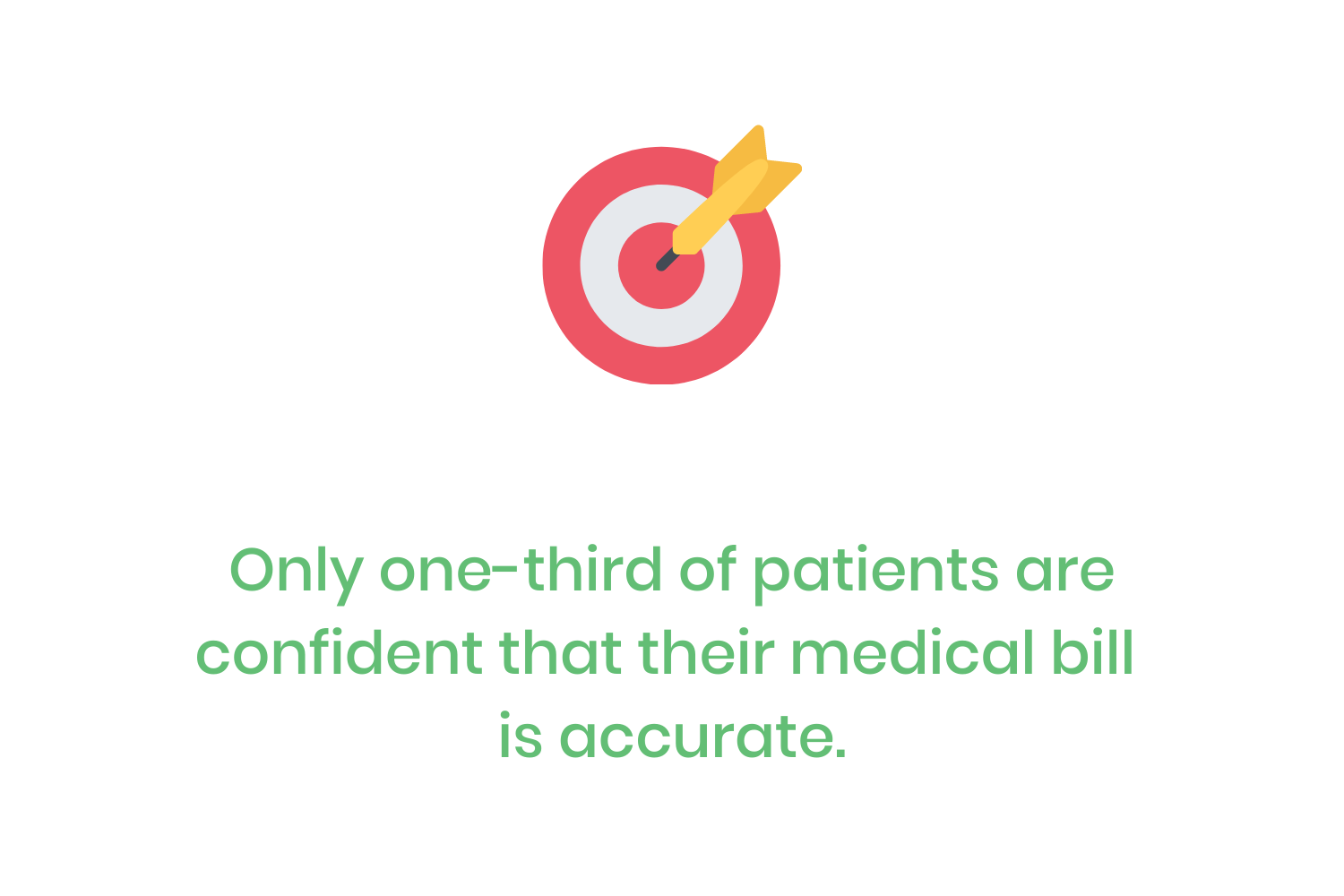Whether it’s during the initial appointment stage or collection, the healthcare process goes through multiple people representing different organizations.
What ends up happening is a “too many cooks in the kitchen” scenario that opens the door to mistakes along the way.
Out of every area during that process, though, medical billing errors seem to happen most often.
Maybe they seem to happen more frequently because they directly affect the everyday patient’s income. Thus, having a higher chance of garnering unwanted attention from national press and local news stations.
Either way, it’s a huge problem that exists that sometimes leads to fraud accusations. It doesn’t matter whether you work at a giant hospital conglomerate or a local practice, you’re held accountable for invoicing mistakes.
But before you can correct anything you need to understand the entire landscape of the problem. Here’s our list of medical billing error statistics from across the industry.
80% of all medical bills contain errors.
(Becker’s Hospital Review)
There are a few different numbers that float around with this statistic.
Some experts across the web say that the number lands somewhere between 30% and 40%. That lower range of numbers comes from an analysis conducted by the University of Minnesota professor, Stephan Parente, quoted in a USA Today article from 2012.
Believe it or not, healthcare was much different back then. More organizations were still transitioning towards going paperless.
Even then, though, some experts believed that number to be closer to 80%. That’s since been the belief of many.
Nearly 50% of all Medicare claims contain errors
(NerdWallet)
It’s definitely not good if you’re on Medicare and there’s a fifty-fifty chance that what you get billed contains a mistake. The whole point of the regulation is to help older, retired citizens so that they no longer have to worry about having health insurance.
So why does this happen?
Since Medicare is health insurance run by the government, it’s naturally more complex. However, what’s most important is their review process.
Private organizations usually review 100% of the claims in order to ensure accuracy. Medicare, however, reviews between 0.5% and 5% at a time. Thus, that means that leaves 95% to 99.5% of Medicare claims paid without review.
Over 411,000 seniors faced double-billing for their Medicare premiums in September 2019.
(Cincinnati Enquirer)
This problem was the result of a glitch in Medicare’s system.
Technology sometimes fails us. In this case, it just happened to be a solution that deals with millions of dollars per day.
Specifically, this event happened as the result of a glitch in the Easy Pay system. When patients tried to pay their Medicare premiums the system ended up double-billing them.
Mistakes on bills cost hospitals $68 billion annually.
(Outsource Strategies)
I’ve provided real-world examples to back up the statement I’m about to say in a couple of statistics later. When billing mistakes happen the organization has to pay it back to their affected clients.
Think of these miscalculations in healthcare like getting a refund for buying something that was on sale at a retail store. The unfortunate reality is that nothing within this industry goes on sale.
However, patients can take solace in knowing that hospitals and other facilities have to take responsibility when medical billing errors occur.
Bills totaling $10,000 or more contained an average error costing $1,300
(ABC News)
Turning what Equifax found and putting it in a loose ratio assumes that 13% of the total of every medical bill is erroneous.
If I were a physician I’d advertise the cost of my services as a 15% off sale for the entirety of my tenure. Of course, I’m being facetious with my reasoning here.
Inaccuracies aren’t something you want to readily advertise. Not to mention that they cost a financial nightmare for facilities of all different sizes.
Medical billing errors mar the credit reports of ~14 million Americans.
(WSJ)
This statistic is one of my favorites. The Wall Street Journal sourced it from a 2011 study conducted by the Commonwealth Fund.
Most likely, the Commonwealth Fund concluded this information based on the percentage of doctor bills on people’s credit reports. They then looked at the likeliness of medical billing errors happening and multiplied that by the first number.
As a result, they could conclude that the amount of Americans with errors affecting their credit is a little higher than the entire population of Pennsylvania.
Over 50% of patients owe $1,000 or more to their doctors.
(Healthcare in America)
As the costs associated with healthcare rise on an annual basis, it’s no surprise that a little over half of all patients owe at least $1,000 to their doctor.
But what’s significant about this is that the actual number that patients owe might be lower considering the percentage of errors on bills.
Let’s say you fall within the range listed within that stat. You pay off what you owe, but a few months later it comes out that the facility you paid your money to found a few problems with their coding. You’d then get money back from them based on the amount they overcharged you.
The way I described it doesn’t sound so bad but in reality, it’s a pain.
The government recovered $2.3 billion in fraudulent healthcare reimbursements in 2018.
(Skilled Nursing News)
There’s no denying that fraud does happen within this industry.
Government agencies get better in their investigation efforts on a yearly basis, which is great.
This also means that they’re placing more scrutiny on errors that happen accidentally. In other words, frequent offenders will end up facing a charge of fraud rather than a fine.
As a result, practices of all sizes need to place more effort on their review process to reduce their invoicing mistakes.
25% of skilled nursing facility (SNF) claims are overpaid.
(Modern Healthcare)
Claims coming out of skilled nursing facilities are under a lot of scrutiny lately.
It’s important to point out that billing errors aren’t purposefully fraudulent the majority of the time. Regardless of what specialty, practices aren’t trying to scam the system and they usually happen as the result of carelessness.
However, reimbursements for SNF are partially based on the number of visits utilized. This, in turn, provides an incentive to charge clients for more visits than medically necessary.
Billing errors result in overcharges of 26% on average.
(M-Scribe Medical Billing)
The majority of inaccurate statements contain line items priced way higher than they should be. I’ve provided an example of this very thing happening at the height of the coronavirus pandemic.
Most of the time overcharges happen due to an internal problem caused during a facility’s internal invoicing process. In order to find where things got messed up along the way, the facility needs to conduct an audit that looks at every facet.
If a little more than 1 in 4 statements sent out contain an overcharged line item, that’s a lot of money to lose.
46% of provider fraud cases were due to duplicate billing and invoicing for services not needed.
(Health Payer Intelligence)
Sure, every provider makes mistakes. But if certain mistakes happen on a consistent basis they may have to answer to an audit from the government.
I went over the in’s and out’s of duplicate billing in a separate blog post. It’s a very common invoicing error that happens when a doctor’s office charges a patient for the same procedure multiple times (among a few other things).
As you can guess by the statistic, it also happens to be one of the most common ways providers face charges for fraud.
Patients paid nearly $1 billion in billing mistakes involving severe malnutrition diagnosis codes.
(Office of the Inspector General)
How does one branch of diagnosis codes end up costing patients so much money in error?
Well, naturally, certain codes cost more money.
To find this disparity, the Office of the Inspector General (OIG) and the Department of Health and Human Services (HHS) had to investigate. They found that many hospitals used two specific ICD-10 codes…
E41 - Nutritional marasmus
E43 - Unspecified severe protein-calorie malnutrition
Both of those codes classify as a type of major complication or comorbidity (MCC). As a result, they cost patients more money for Medicare-specific claims.
OIG concluded that almost 250,000 Medicare claims contained at least one of the codes between 2016 and 2017. They determined that facilities who used these codes should’ve used other malnutrition codes or none at all.
Maury Regional Medical Center paid almost $2 million to settle overpayments.
(News Channel 5 Nashville)
As the saying goes, “All PR is good PR.” I’d argue that that saying doesn’t hold true for healthcare organizations, especially when it means local news stations pointing out your inaccuracies.
However, Maury Regional Medical Center deserves credit for its transparency. They ended up finding their errors through an internal review from an independent auditor.
After receiving the auditor’s findings, the organization then self-reported their situation to the government.
In the end, the OIG found that Maury Regional Medical Center received payments unsupported by their records between 2013 to 2019.
The medical billing outsourcing market value will hit $8 billion by 2026.
(Research and Markets)
Outsourcing continues to grow in popularity among practices because it makes their daily operations run a little smoother.
It’s not always the perfect option, though. By outsourcing, they run the risk of choosing a vendor who doesn’t have the best compliance practices. Or they don’t have the functionality within their system to deal with a health crisis like what happened to GDL.
Either way, it’s important to evaluate vendors thoroughly before choosing one.
ICD-11 contains nearly 4x more codes than ICD-10.
(Becker’s ASC Review)
At the time of writing, ICD-10 is still the accepted handbook used for classifying diseases. But two years from now, the new version, ICD-11, releases.
ICD-11 contains four-times more codes within it than ICD-10 and a problem with careless mistakes made by billers and coders already exists.
As a result, technological advancements and governmental stipulations will have no choice but to get involved to ensure that patients don’t get overcharged.
70% of U.S. patients aren’t motivated to get a second opinion
(Harvard Medical School)
Why is this such an important statistic? Well, since a patient has such a high chance of receiving and erroneous statement from their doctor, it behooves them to get a second opinion.
If they don’t, then it’s that much harder to realize that the amount they’re paying or their treatment is inaccurate. That’s the unfortunate reality that the majority of patients face, though.
Although, they might be a little bit more motivated to seek out a second opinion if they knew some of the statistics listed here.
A Texas-based Lab charged over $2,000 for one COVID-19 Test.
(Dark Daily)
When a global pandemic hits, a lot happens in a short amount of time. There’s no way around it.
In 2020, there was a lot of unknown surrounding COVID-19, leading to widespread panic. As a result, healthcare facilities had to prepare for infected patients and distribute tests on a seemingly endless basis. This also lead to an increase in burnout among physicians as well, but that’s a different story.
The unique nature of the events mixed in with billing to insurances opened up the door to errors.
Gibson Diagnostic Labs (GDL) located in Austin, Texas ran into that issue at the height of the pandemic when they charged 117 clients over $2,000 for a COVID-19 test.
GDL placed blame on its third-party billing system for the errors.
One-third of patients are confident that their medical bill is accurate.
(Salucro Healthcare Solutions)
This statistic contradicts one I listed earlier.
It suggests that the majority of patients aren’t confident in the invoices they receive from their doctors. If they don’t feel that comfortable with what they’re required to pay, what should they do?
Google anything related to lowering medical bills and millions of blog posts will pop up with their suggestions. But out of everything suggested, they should ask for a second opinion.
Thus, bringing me to the earlier statistic that most patients aren’t motivated to do so. An interesting predicament.
2 out of every 20 patients catch an error in EHR notes.
(Journal of the American Medical Association)
If you’ve kept up with industry trends then it isn’t a surprise that patients actively look at their medical records. Transparency in healthcare continues to grow in importance.
What is a surprise, though, is the fact that a relatively high percentage of them are finding errors in EHR notes.
The EHR is the first place the billing process starts. In other words, if there’s a mistake there then there’s a much higher chance that something else will go wrong by the time a patient’s asked to pay.
41% of patients find their medical bill totals surprising.
(Bankrate)
This statistic is a mixed result of patients not understanding exactly what’s covered by their insurance and receiving surprised bills.
Either instance is bad. Not knowing their insurance falls on the patient. Receiving a statement from an out of network physician is a completely different story that’s currently receiving a lot of press.
However, the third reason for this statistic could be due to a billing error. As I’ve touched on throughout this blog post, overcharging is a mistake that’s running rampant throughout the healthcare industry.
35% of workers’ compensation bills contained some type of error.
(M Power)
If you get injured on the job, you’ll most likely have to tap into workers compensation. This is especially the case for people who work within a blue-collar industry.
Imagine getting injured, billed for an overpayment by your health insurance and then finding out that there was an error in your worker’s comp. That’s a recipe for disaster.
The reason why this statistic landed within this blog post was to illustrate that billing errors land outside of the healthcare industry as well
Conclusion
I want to reiterate that, although the majority of medical billing errors fall under the category of fraud, most facilities aren’t committing these mistakes purposefully.
We know that the healthcare industry is highly regulated within the United States. After all, it’s always one of the leading topics during presidential elections. But before any positive change can happen, the industry has to accept its current state.
As I’ve pointed out throughout this blog post, mistakes during the invoicing stage happen often. That’s a hard pill to swallow but it’s the truth.
That way healthcare organizations can come together, implement better workflows and face this challenge head-on.











